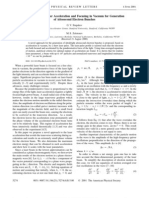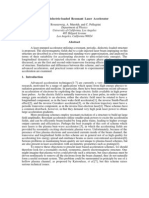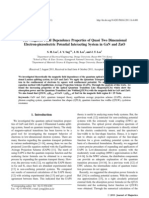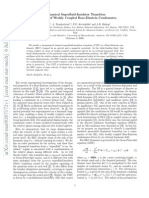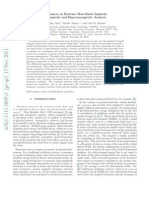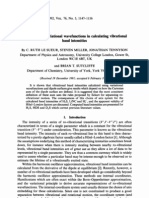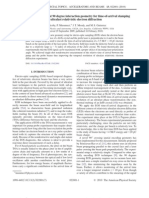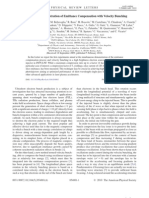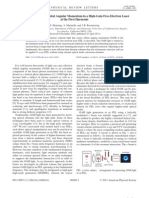Stable Charged-Particle Acceleration and Focusing in A Laser Accelerator Using Spatial Harmonics
Uploaded by
Particle Beam Physics LabStable Charged-Particle Acceleration and Focusing in A Laser Accelerator Using Spatial Harmonics
Uploaded by
Particle Beam Physics LabStable Charged-Particle Acceleration and Focusing in a
Laser Accelerator Using Spatial Harmonics
B. Naranjo, A. Valloni, S. Putterman, and J. B. Rosenzweig
Department of Physics and Astronomy, University of California, Los Angeles, California 90095-1547, USA
(Received 13 October 2011; revised manuscript received 25 June 2012; published 19 October 2012)
Regarding the laser-driven acceleration of charged particles in photonic systems, a central unmet
challenge is the achievement of simultaneous transverse and longitudinal stability at nonultrarelativistic
energies. At such energies, Earnshaws theorem [S. Earnshaw, Trans. Cambridge Philos. Soc. 7, 97
(1842)] indicates that a synchronous accelerating wave gives a defocusing effect. We present a scheme in
which particles are accelerated by interaction with a resonant spatial harmonic and are focused by strong
ponderomotive interaction with nonresonant spatial harmonics. We show that this scheme exhibits net
transverse focusing and longitudinal stability, and we discuss its use in a compact laser accelerator.
DOI: 10.1103/PhysRevLett.109.164803 PACS numbers: 41.75.Jv, 29.27.a, 41.75.Lx
To meet the needs of future high-energy physics accel-
erators and x-ray free-electron lasers, there has been sig-
nicant recent research into very high eld (>GV,m)
acceleration techniques [1,2] that hybridize existing accel-
erator technology with optical technology such as lasers
[3,4] and photonic band-gap crystals [5]. To permit opera-
tion at very high elds in the optical regime, a laser
structure accelerator (LSA) should abandon the use of
metals in favor of dielectrics [6]. In contrast to the near-
axisymmetry used in standard radio frequency (rf) linear
accelerators (linacs), the system should have a eld con-
guration with approximately two-dimensional Cartesian
symmetry [4,5]. This transverse asymmetry gives two
advantages that permit large charge uxes. First, space-
charge self-forces, which are highly disruptive at low
energy, are geometrically mitigated. Second, destabilizing
transverse wakeelds, which are a signicant challenge in
high-frequency accelerators, are greatly diminished [7].
The charged-particle dynamics in LSAs present distinct
challenges. In an accelerating wave of magnitude E and
wave vector k, a charged particles longitudinal dynamics
may be categorized according to the ratio of its increase in
to its advance in phase, n qE,kmc
2
. Electron dynam-
ics in rf linacs, where n $1, are straightforward in that the
electrons phase motion quickly becomes negligible, as
relativistic velocities are achieved early in the acceleration
process. In contrast, for n (1, appropriate for ions in rf
linacs and electrons in GV,m infrared LSAs, the dynamics
are more intricate and are described in terms of stable
regions, termed buckets, localized in longitudinal phase
space around resonant nonultrarelativistic velocities. For
electron LSAs, the time scale of this motion is sub-fs and
the beams narrow transverse dimension is on the scale of
microns. Accordingly, an LSA should employ very small
normalized emittances, e
y,n
10
9
10
10
m rad, as well
as an effective focusing scheme. In proton linacs, synchro-
nous defocusing is counteracted by use of external focus-
ing. This approach may not be used in optical accelerators,
as the length scales are too short for standard magnetic
devices. Thus, one is forced to examine focusing provided
by the second-order transverse forces associated with the
electromagnetic mode itself. Second-order focal effects are
obtained by varying the elds in a time-dependent fashion,
for which Xie has proposed an alternating phase scheme
[8]. However, the resultant second-order acceleration is
quite complex and inherently weak.
Addressing these dynamics problems, we propose a
new scheme that utilizes an accelerator eigenmode con-
sisting of multiple spatial harmonics. Acceleration is pro-
vided by a resonant spatial harmonic, while second-order
focusing [9] sufcient to overcome the resonant waves
defocusing is provided by nonresonant spatial harmonics.
Furthermore, we demonstrate that the longitudinal motion
associated with the resonant bucket is not destabilized by
the presence of these perturbing nonresonant waves.
Consider a dielectric periodic along the beam axis,
ex
?
, z ex
?
, z J. The electric eld of a mode hav-
ing wave vector k^ z and angular frequency w can then be
written in Floquet form, Ex, i E
0
e
|kzwi
ux, where
ux
?
, z J ux
?
, z. Assuming the convention that k
lies in the rst Brillouin zone, r,J <k r,J. Because
u is periodic in z, one may write the longitudinal eld as
E
z
|E
0
X
n
z
o
n
z
e
|k
n
z
zwi
, (1)
where k
n
z
k 2rn
z
,J, and the sum is taken over all
integers n
z
. For later convenience, an overall phase of |
has been extracted. The eld in Eq. (1) is decomposed
into spatial harmonics, each having the same temporal
frequency but different phase velocity
n
z
w,k
n
z
.
Acceleration by resonant interaction occurs when the par-
ticles velocity is nearly equal to the phase velocity of one
of the spatial harmonics, which we label n
0
.
As the essential features are present in a simplied 2D
analysis, all eld variation with x is dropped for now.
PRL 109, 164803 (2012)
P HYS I CAL RE VI E W L E T T E RS
week ending
19 OCTOBER 2012
0031-9007,12,109(16),164803(5) 164803-1 2012 American Physical Society
Therefore, one may classify the modes as to whether the
eld in the plane is electric or magnetic [10]. To permit
acceleration along the z axis, assume that the mode under
consideration is electric in the plane, so that the only non-
vanishing eld components are E
y
, E
z
, and B
x
. Further
assume that the dielectric has mirror symmetry about the
y 0 plane, ex eM
y
x, where the mirror-reection
operator M
y
is dened by its action on a three-vector,
M
y
h
x
,
y
,
z
i h
x
,
y
,
z
i. Combining this with our
previous assumption that k lies along the z axis, the elds
are either even (upper sign) or odd (lower sign) under y
reection [10],
M
y
EM
y
x Ex and M
y
BM
y
x Bx.
Consistent with the demands of focusing and acceleration,
only consider even modes so that E
y
and B
x
are odd
functions about y 0, while E
z
is an even function about
y 0. For small displacements y from the beam axis
(y,J (1) to lowest nonvanishing order, Gausss law,
E
y
yE
z
,z, gives
E
y
yE
0
X
n
z
o
n
z
k
n
z
e
|k
n
z
zwi
.
Likewise, the lowest order transverse component of the
magnetic eld from Ampe`res law, B
x
y,c
2
E
z
,i,
is obtained giving
B
x
yE
0
c
2
X
n
z
o
n
z
k
n
z
n
z
e
|k
n
z
zwi
.
One nal simplifying assumption is that all of the ampli-
tudes o
n
z
are real, which can always be arranged for a
dielectric lattice having both spatial-inversion and time-
reversal symmetries. Without loss of generality, set o
n
0
1.
For an electron traveling at approximately the resonant
phase velocity, we substitute [ z
n
0
i and dene w
n
0
2rw,k
n
0
J so that the Lorentz force FeE
n
0
^ zB
may be written
E
|
x, i Re
X
q
]
|,q
xe
|qw
n
0
i
, (2)
where the sum is over all integers q and
]
y,q
yeE
0
o
n
0
q
k
n
0
q
1
n
0
n
0
q
e
|k
n
0
q
[
,
]
z,q
|eE
0
o
n
0
q
e
|k
n
0
q
[
.
Several observations are made of the Lorentz force. First,
the resonant spatial harmonic q 0 is considered. Dening
the particle phase k
n
0
[, the transverse and longitudinal
contributions are yeE
0
k
n
0
,
2
n
0
cos and eE
0
sin,
respectively. For stable longitudinal acceleration, which
requires r,2 <<0, the transverse force is defocusing.
Second, the nonresonant spatial harmonics q 0 is consid-
ered. The transverse components vanish for
n
0
n
0
q
c
2
and are otherwise proportional to k
n
0
q
2
n
0
k
n
0
.
Following the analysis of Ref. [11], the electron motion
is separated into a slowly varying secular component
X
|
i and a rapidly varying component (
|
i, x
|
i
X
|
i (
|
i, so that the secular equations of motion for
a force having the form of Eq. (2) are
m
e
12u
|,z
n
0
X
|
Re]
|,0
X
X
]
X
q0
1
2m
e
12u
],z
n
0
q
2
w
2
n
0
Re
]
|,q
x
]
]
],q
]
],q
X
.
Adopting the beam physics convention of using z as
the independent variable and introducing the notation
0
J,Jz 1,
n
0
J,Ji,
Y
00
Y
n
n
0
k
2
n
0
3
n
0
2
n
0
cos
n
2
n
0
w
2
2
2
n
0
4
n
0
w
2
n
0
B D
C E cos2
, (3)
where
n
n
0
eE
0
k
n
0
m
e
c
2
eE
0
n
0
2rm
e
c
2
e >0,
B
X
q0
o
2
n
0
q
k
2
n
0
q
q
2
1
n
0
n
0
q
2
,
C
X
q0
o
n
0
q
o
n
0
q
k
n
0
q
k
n
0
q
q
2
1
n
0
n
0
q
1
n
0
n
0
q
,
D
1
2
n
0
X
q0
o
2
n
0
q
k
2
n
0
q
1
n
0
n
0
q
q
2
,
E
1
2
n
0
X
q0
o
n
0
q
o
n
0
q
k
2
n
0
q
1
n
0
n
0
q
q
2
.
The transverse secular equation of motion, Eq. (3), yields the
criteria for simultaneous acceleration and stabilization.
The term linear in E
0
is the resonant defocusing term, and
the term quadratic in E
0
is the average effect of the rapidly
oscillating nonresonant spatial harmonics. More specically,
the terms B and C are due to the rapid transverse motion,
whereas the terms D and E are due to the rapid longitudinal
motion. The direct terms B and Dare unconditionally focus-
ing, whereas the interference terms C and E are either
focusing or defocusing, depending on the particle phase .
These interference terms result from a nonresonant spatial
harmonic driving the rapid motion, while an oppositely
traveling wave, relative to the synchronous frame, is sampled
by the averaging procedure.
Because the ponderomotive focusing terms in Eq. (3) are
proportional to 1,q
2
w
2
n
0
, the focusing strength can be sig-
nicantly increased by reducing w
n
0
2r
n
0
,J. Consider,
at rst, a photonic accelerator whose longitudinal periodicity
PRL 109, 164803 (2012)
P HYS I CAL RE VI E W L E T T E RS
week ending
19 OCTOBER 2012
164803-2
J is of the same order as the photonic lattice constant o. As
useful photonic band gaps typically lie in the frequency
range wo,2rc o, $1, one has w
n
0
$
n
0
w.
Therefore, the frequencies of the rapidly varying forces
are in the optical range, and the ponderomotive focusing
force remains correspondingly weak. If, instead, we con-
sider a photonic accelerator whose smallest repeating
length (i.e., the primitive lattice constant) along the longi-
tudinal direction is J Na, then w
n
0
$
n
0
w,N and the
ponderomotive focusing force grows correspondingly
strong. We specify that J is then primitive so that both of
the q 1 spatial harmonics do not identically vanish by
symmetry.
Breakdown ultimately limits the peak axial eld that can
be used. For the accelerator eigenmodes under considera-
tion, the peak axial eld is typically larger than the peak
dielectric eld, roughly E
peak axial
,E
peak dielect
$1.5. The
breakdown electric eld for a pulse propagating in a dielec-
tric [12] is E
peak dielect
E
th
,rce
0
p
, where E
th
is the ma-
terials damage threshold and r is the pulse length. Due to
its high dielectric coefcient and compatibility with micro-
fabrication techniques, we are strongly considering silicon
at 5 m. The damage threshold has yet to be measured in
silicon at 5 m for & ps pulses, but Soong et al. [13]
measured E
th
0.35 J,cm
2
at 2.2 m for 1 ps pulses. At
5 m, multiphoton ionization will be weaker, but tunnel
ionization will be stronger. Using this value of E
th
and
r 80 fs gives E
peak axial
6 GV,m. Other promising
materials in the infrared are sapphire and quartz, which
have more than an order-of-magnitude improvement in E
th
over silicon, at the cost of a smaller dielectric constant.
Consider the case where the only nonvanishing nonre-
sonant spatial harmonic is q 1, which provides two
simplications. First, it avoids interference terms in the
transverse secular equation of motion, so that C E 0
in Eq. (3). Second, taking the nonresonant spatial harmonic
to be slower (q >0) than the resonant spatial harmonics
avoids the mutual cancellation of the transverse electric
and magnetic forces at
n
0
n
0
q
c
2
. Comparing the
resonant defocusing forces maximum value at 0
with the nonresonant focusing forces minimum value (in
this case, the focusing force does not depend on ) yields
the transverse stability diagram shown in Fig. 1.
Having identied the transverse stability condition, we now
concentrate on longitudinal dynamics. Examining briey only
the effect of the resonant wave, we dene the momentum
deviation u
z
n
0
, where
n
0
n
0
n
0
m
e
c. Then, we
write the electrons small-amplitude longitudinal
Hamiltonian as [14]
H[, u % m
e
c
2
2
n
0
u
2
2
n
0
2
n
0
n
n
0
cossin
0
,
where we have allowed for an accelerating bucket by
setting the synchronous phase
0
<0. As this
Hamiltonian is a constant of the motion, one may deduce
the dimensions of the stable bucket in longitudinal phase
space.
To examine the dynamics in the presence of nonresonant
harmonics, the equation of motion is numerically solved as
Ju,
n
0
J
~
i
n
n
0
k
n
0
J
2
n
0
n
0
sinsin
0
X
q0
o
n
0
q
sink
n
0
q
,k
n
0
2rq
~
i
J
J
~
i
k
n
0
J
2
n
0
u,
n
0
, (4)
where
~
i w
n
0
i,2r is a dimensionless time variable nor-
malized so that
~
i 1 corresponds to a single period of the
micromotions lowest frequency components (q 1).
Two example cases,
n
0
6 and
n
0
1000, with
stable acceleration parameters, are shown in Table I.
Simultaneously integrating both the longitudinal equation
of motion, Eq. (4), and the transverse equation of motion,
m
e
y E
y
, both of these cases were veried to be stable.
Figure 2 shows longitudinal phase-space trajectories for
the
n
0
6 case. Even with such large amplitude perturb-
ing waves, a stable bucket structure is observed. Though
1 10 100 1000 10000
10
100
1000
100 MV/m
200 MV/m
400 MV/m
1 GV/m
2 GV/m
4 GV/m
FIG. 1 (color online). Stability diagram for a single nonreso-
nant spatial harmonic o
n
0
1
0. Increasing the slow modulation
length N and increasing the particle energy
n
0
improves trans-
verse stability and gives higher values of the accelerating eld E
0
for a xed net eld E
0
1 jo
n
0
1
j 6 GV,m. Locations of the
two example cases discussed in the text are shown with dot
markers. The region below the dotted line (, 0.03) is longi-
tudinally unstable. (o 1.15 m and 5 m).
TABLE I. Low- and high-energy example cases yielding
transverse and longitudinal stability with accelerating gradients
!1 GeV,m. [N 250 and E
0
1 o
n
0
1
6 GV,m].
n
0
E
0
(GV,m) o
n
0
1
E
0
(GV,m) GeV,m
6 1.414 4.586 1.0
1000 3.536 2.464 2.5
PRL 109, 164803 (2012)
P HYS I CAL RE VI E W L E T T E RS
week ending
19 OCTOBER 2012
164803-3
increasing N improves transverse stability, it also moves
the nonresonant buckets closer to the resonant buckets.
When the border regions of the two buckets overlap, the
trajectories become longitudinally unstable according to
the Chirikov criterion [15]. For instance, in Fig. 2, the
nonresonant buckets travel towards the left and are located
at u,
n
0
0.33, far enough below the resonant buckets
to not destabilize the trajectories. An approximately
equivalent longitudinal stability criterion,
q
2r
k
n
0
eE
0
o
n
0
q
2rm
3
n
0
q
2
w
2
n
0
,,
is shown in Fig. 1, where , has been determined via
comparison with numerical results.
We now give a brief example of a band-gap-conned
waveguide accelerator that provides nonresonant focusing.
It consists of a linear channel and a triangular lattice of holes
etched into silicon (see Fig. 3 and movies in Supplemental
Material [16]). The channel width is modulated over a
distance of J 8o, where o is the lattice constant. This
provides a mix of spatial harmonics, particularly a slow
sideband and a fast sideband. The beam is synchronized to
the fast sideband, labeled q 0 in Fig. 4(a). Then the q 1
spatial harmonic provides the majority of nonresonant focus-
ing, as shown by the spatial harmonic spectrum in Fig. 4(b).
To design for large N, we treat the slow modulation as a
cyclic adiabatic variation [17]. This 2D design can be gen-
eralized to a 3D design incorporating either a single nite
slab or a stack of nite slabs. In 3D, the mode is conned in
the plane by total internal reection, provided that the spatial
-0.40 -0.35 -0.30 -0.25 -0.20 -0.15 -0.10 -0.05 0.00
-0.10
-0.05
0.00
0.05
0.10
FIG. 2 (color online). Longitudinal phase-space trajectories
for a bucket having acceleration gradient 1 GeV,m being per-
turbed by a strong nonresonant wave. The blue orbits are
obtained by averaging the phase space motion over a single
period
~
i 1. The dotted line is the raw phase-space motion for
the outermost blue orbit, showing the rather violent nonresonant
longitudinal motion that provides approximately 40% of the
transverse stability in this case. The black line is the separatrix
obtained from the unperturbed Hamiltonian. [N 250,
n
0
6,
E
n
0
2
p
GV,m, E
0
1 o
n
0
1
6 GV,m,
0
r,4].
FIG. 3 (color online). Accelerator eigenmode simultaneously
providing both transverse focusing and longitudinal acceleration.
Arrows indicate electric eld, and color shading indicates mag-
netic eld in silicon. Unshaded channel in center and holes
represent vacuum. Slow modulation of the waveguide ngers
(N 8) produces two sidebands about the unmodulated wave-
guide mode. Beam is synchronized to the fast sideband. Here, we
take the design particles to be positrons, so that the synchronous
phase
0
is 3r,4. See movies in Supplemental Material [16].
(o 1.15 m and 5 m)
-0.5 0.0 0.5 1.0
0.00
0.05
0.10
0.15
0.20
0.25
0.30
0.35
(a)
-20 -15 -10 -5 0 5 10 15 20
0.0
0.5
1.0
1.5
2.0
2.5
3.0
(b)
FIG. 4 (color online). Spectral properties of the accelerator
eigenmode shown in Fig. 3. (a) Band diagram. Three spatial
harmonics are shown with thick lines. The fast sideband, q 0,
is the resonant spatial harmonic and is approximately speed-of-
light. The strongest nonresonant harmonic, q 1, is slightly
slower and provides the majority of the transverse focusing.
(b) Spatial harmonic spectrum. The strength of the two side-
bands, q 0 and q 2, relative to the unmodulated spatial
harmonic, q 1, can be increased by increasing the depth of the
slow modulation.
PRL 109, 164803 (2012)
P HYS I CAL RE VI E W L E T T E RS
week ending
19 OCTOBER 2012
164803-4
harmonics are mostly underneath the light cone. For trans-
verse particle connement in the x direction, the mode can be
adjusted so that it is resonantly focusing.
The approach presented here thus provides simultaneous
transverse and longitudinal stability, as shown by relevant
examples. The application of these results now takes on a
certain urgency, as it may be essential in guiding LSA
structure designs in numerous research programs, includ-
ing an all-optical free-electron laser, with both accelerator
and undulator [18] driven by lasers.
This work is supported by DARPA under Contract
No. N66001-11-1-4197, the U.S. DOE under Contracts
No. DE-FG02-07ER46272 and No. DE-FG03-92ER40693,
and the ONR under Contract No. N00014-06-1-0925. B. N.
and S. P. wish to thank DARPA MTO for support under the
SERS program, covering work on photonic accelerators.
[1] I. Blumenfeld, C. E. Clayton, F.-J. Decker, M. J. Hogan, C.
Huang, R. Ischebeck, R. Iverson, C. Joshi, T. Katsouleas,
N. Kirby et al., Nature (London) 445, 741 (2007).
[2] W. P. Leemans, B. Nagler, A. J. Gonsalves, C. Toth, K.
Nakamura, C. G. R. Geddes, E. Esarey, C. B. Schroeder,
and S. M. Hooker, Nat. Phys. 2, 696 (2006).
[3] X. E. Lin, Phys. Rev. ST Accel. Beams 4, 051301 (2001).
[4] Z. Zhang, S. G. Tantawi, and R. D. Ruth, Phys. Rev. ST
Accel. Beams 8, 071302 (2005).
[5] B. M. Cowan, Phys. Rev. ST Accel. Beams 11, 011301
(2008).
[6] J. Rosenzweig, A. Murokh, and C. Pellegrini, Phys. Rev.
Lett. 74, 2467 (1995).
[7] A. Tremaine, J. Rosenzweig, and P. Schoessow, Phys. Rev.
E 56, 7204 (1997).
[8] M. Xie, in Proceedings of the European Particle
Accelerator Conference (JACOW, Vienna, 2000), p. 895.
[9] J. Rosenzweig and L. Serani, Phys. Rev. E 49, 1599
(1994).
[10] J. D. Joannopoulos, S. G. Johnson, J. N. Winn, and
R. D. Meade, Photonic Crystals: Molding the Flow of
Light (Princeton University Press, Princeton, NJ, 2008),
2nd ed.
[11] L. D. Landau and E. M. Lifshitz, Mechanics, Course of
Theoretical Physics Vol. 1 (Pergamon Press, Oxford,
1976), 3rd ed.
[12] C. McGuinness, E. Colby, and R. L. Byer, J. Mod. Opt. 56,
2142 (2009).
[13] K. Soong, R. L. Byer, C. McGuinness, and E. Peralta, in
Proc. of 2011 Particle Accelerator Conf. (IEEE, New
York, 2011), p. 277.
[14] J. Rosenzweig, Fundamentals of Beam Physics (Oxford
University Press, New York, 2003).
[15] B. V. Chirikov, J. Nucl. Energy, Part C 1, 253 (1960).
[16] See Supplemental Material at http://link.aps.org/
supplemental/10.1103/PhysRevLett.109.164803 for mov-
ies of accelerator eigenmode.
[17] S. G. Johnson, P. Bienstman, M. A. Skorobogatiy, M.
Ibanescu, E. Lidorikis, and J. D. Joannopoulos, Phys.
Rev. E 66, 066608 (2002).
[18] T. Plettner and R. L. Byer, Phys. Rev. STAccel. Beams 11,
030704 (2008).
PRL 109, 164803 (2012)
P HYS I CAL RE VI E W L E T T E RS
week ending
19 OCTOBER 2012
164803-5
You might also like
- THEORY OF THE ЕН AND HZ ANTENNAS EH - HZNo ratings yetTHEORY OF THE ЕН AND HZ ANTENNAS EH - HZ7 pages
- Using The Relativistic Two-Stream Instability For The Generation of Soft-X-Ray Attosecond Radiation PulsesNo ratings yetUsing The Relativistic Two-Stream Instability For The Generation of Soft-X-Ray Attosecond Radiation Pulses5 pages
- L. C. Andreani, OPTICAL TRANSITIONS, EXCITONS, AND POLARITONS IN BULK AND LOW-DIMENSIONAL SEMICONDUCTOR STRUCTURES, 1993No ratings yetL. C. Andreani, OPTICAL TRANSITIONS, EXCITONS, AND POLARITONS IN BULK AND LOW-DIMENSIONAL SEMICONDUCTOR STRUCTURES, 199356 pages
- L.O. Baksmaty Et Al - Tkachenko Waves in Rapidly Rotating Bose-Einstein CondensatesNo ratings yetL.O. Baksmaty Et Al - Tkachenko Waves in Rapidly Rotating Bose-Einstein Condensates4 pages
- G.V. Stupakov and M. S. Zolotorev - Ponderomotive Laser Acceleration and Focusing in Vacuum For Generation of Attosecond Electron BunchesNo ratings yetG.V. Stupakov and M. S. Zolotorev - Ponderomotive Laser Acceleration and Focusing in Vacuum For Generation of Attosecond Electron Bunches4 pages
- V.I. Berezhiani and S.M. Mahajan - Beat-Wave Generation of Plasmons in Semiconductor PlasmasNo ratings yetV.I. Berezhiani and S.M. Mahajan - Beat-Wave Generation of Plasmons in Semiconductor Plasmas6 pages
- R. R. Lindberg Et Al - Robust Autoresonant Excitation in The Plasma Beat-Wave AcceleratorNo ratings yetR. R. Lindberg Et Al - Robust Autoresonant Excitation in The Plasma Beat-Wave Accelerator4 pages
- Optical Fibers: Structures, Waveguiding & FabricationNo ratings yetOptical Fibers: Structures, Waveguiding & Fabrication49 pages
- Longitudinal Profile Diagnostic Scheme With Subfemtosecond Resolution For High-Brightness Electron BeamsNo ratings yetLongitudinal Profile Diagnostic Scheme With Subfemtosecond Resolution For High-Brightness Electron Beams8 pages
- Optical Fibers: Structures, Optical Fibers: Structures, Waveguiding & FabricationNo ratings yetOptical Fibers: Structures, Optical Fibers: Structures, Waveguiding & Fabrication99 pages
- V.I. Karas Et Al - Kinetic Simulation of Fields Excitation and Particle Acceleration by Laser Beat Wave in Non-Homogeneous PlasmasNo ratings yetV.I. Karas Et Al - Kinetic Simulation of Fields Excitation and Particle Acceleration by Laser Beat Wave in Non-Homogeneous Plasmas3 pages
- K.P. Shamrai Et Al - Nonlinear Phenomena in Helicon PlasmasNo ratings yetK.P. Shamrai Et Al - Nonlinear Phenomena in Helicon Plasmas5 pages
- K. Nakamura Et Al - Levitation of Spinor Bose-Einstein Condensates: Macroscopic Manifestation of The Franck-Condon EffectNo ratings yetK. Nakamura Et Al - Levitation of Spinor Bose-Einstein Condensates: Macroscopic Manifestation of The Franck-Condon Effect8 pages
- Observation of Laser-Induced Field-Free Permanent Planar Alignment of MoleculesNo ratings yetObservation of Laser-Induced Field-Free Permanent Planar Alignment of Molecules6 pages
- Discussion On Electromagnetic Waves Under The Circumstances of Total Internal Reflection and Optical TunnelingNo ratings yetDiscussion On Electromagnetic Waves Under The Circumstances of Total Internal Reflection and Optical Tunneling6 pages
- Optical Fibers: Structures, Waveguiding & FabricationNo ratings yetOptical Fibers: Structures, Waveguiding & Fabrication54 pages
- Attosecond Rabi Oscillations in High Harmonic Generation Resonantly Driven - 2404.04053v2No ratings yetAttosecond Rabi Oscillations in High Harmonic Generation Resonantly Driven - 2404.04053v211 pages
- 2-Array of Bose-Einstein Condensates Under Time-Periodic Feshbach-Resonance ManagementNo ratings yet2-Array of Bose-Einstein Condensates Under Time-Periodic Feshbach-Resonance Management8 pages
- Dynamical Superfluid-Insulator Transition in A Chain of Weakly Coupled Bose-Einstein CondensatesNo ratings yetDynamical Superfluid-Insulator Transition in A Chain of Weakly Coupled Bose-Einstein Condensates5 pages
- Resonances in Extreme Mass-Ratio Inspirals: Asymptotic and Hyperasymptotic AnalysisNo ratings yetResonances in Extreme Mass-Ratio Inspirals: Asymptotic and Hyperasymptotic Analysis12 pages
- Yu.V. Tolstykh Et Al - Relativistic Unsteady Petschek-Type Model of Magnetic ReconnectionNo ratings yetYu.V. Tolstykh Et Al - Relativistic Unsteady Petschek-Type Model of Magnetic Reconnection5 pages
- Progress in Electromagnetics Research M, Vol. 28, 273-287, 2013No ratings yetProgress in Electromagnetics Research M, Vol. 28, 273-287, 201315 pages
- Hamse Y. Mussa and Jonathan Tennyson - Calculating Quasi-Bound Rotation-Vibrational States of HOCl Using Massively Parallel ComputersNo ratings yetHamse Y. Mussa and Jonathan Tennyson - Calculating Quasi-Bound Rotation-Vibrational States of HOCl Using Massively Parallel Computers9 pages
- C. Ruth Le Sueuer Et Al - On The Use of Variational Wavefunctions in Calculating Vibrational Band IntensitiesNo ratings yetC. Ruth Le Sueuer Et Al - On The Use of Variational Wavefunctions in Calculating Vibrational Band Intensities10 pages
- S. Wuster, T.E. Argue and C.M. Savage - Numerical Study of The Stability of Skyrmions in Bose-Einstein CondensatesNo ratings yetS. Wuster, T.E. Argue and C.M. Savage - Numerical Study of The Stability of Skyrmions in Bose-Einstein Condensates8 pages
- (Aharonov, Y.; Susskind, L.) Observability of the Sign Change of Spinors Under 2π RotationsNo ratings yet(Aharonov, Y.; Susskind, L.) Observability of the Sign Change of Spinors Under 2π Rotations2 pages
- Side-Coupled Slab-Symmetric Structure For High-Gradient Acceleration Using Terahertz PowerNo ratings yetSide-Coupled Slab-Symmetric Structure For High-Gradient Acceleration Using Terahertz Power9 pages
- Laser Induced Electron Acceleration in An Electromagnetic Standing Wave Wiggler With External Magnetic Tapering ParametersNo ratings yetLaser Induced Electron Acceleration in An Electromagnetic Standing Wave Wiggler With External Magnetic Tapering Parameters4 pages
- Negative Mass and Negative Refractive Index in Atom Nuclei - Nuclear Wave Equation - Gravitational and Inertial Control: Part 2: Gravitational and Inertial Control, #2From EverandNegative Mass and Negative Refractive Index in Atom Nuclei - Nuclear Wave Equation - Gravitational and Inertial Control: Part 2: Gravitational and Inertial Control, #2No ratings yet
- Bruin Buy Supplier Site Order Form: Fedex International Fedex DomesticNo ratings yetBruin Buy Supplier Site Order Form: Fedex International Fedex Domestic1 page
- Single-Shot Coherent Diffraction Imaging of Microbunched Relativistic Electron Beams For Free-Electron Laser ApplicationsNo ratings yetSingle-Shot Coherent Diffraction Imaging of Microbunched Relativistic Electron Beams For Free-Electron Laser Applications5 pages
- Single-Shot Coherent Diffraction Imaging of Microbunched Relativistic Electron Beams For Free-Electron Laser ApplicationsNo ratings yetSingle-Shot Coherent Diffraction Imaging of Microbunched Relativistic Electron Beams For Free-Electron Laser Applications5 pages
- Time-Domain Measurement of A Self-Amplified Spontaneous Emission Free-Electron Laser With An Energy-Chirped Electron Beam and Undulator TaperingNo ratings yetTime-Domain Measurement of A Self-Amplified Spontaneous Emission Free-Electron Laser With An Energy-Chirped Electron Beam and Undulator Tapering4 pages
- Electro-Optic Sampling at 90 Degree Interaction Geometry For Time-Of-Arrival Stamping of Ultrafast Relativistic Electron DiffractionNo ratings yetElectro-Optic Sampling at 90 Degree Interaction Geometry For Time-Of-Arrival Stamping of Ultrafast Relativistic Electron Diffraction7 pages
- Experimental Demonstration of Emittance Compensation With Velocity BunchingNo ratings yetExperimental Demonstration of Emittance Compensation With Velocity Bunching4 pages
- Self-Amplified Spontaneous Emission Free-Electron Laser With An Energy-Chirped Electron Beam and Undulator TaperingNo ratings yetSelf-Amplified Spontaneous Emission Free-Electron Laser With An Energy-Chirped Electron Beam and Undulator Tapering4 pages
- Resonant Excitation of Coherent Cerenkov Radiation in Dielectric Lined WaveguidesNo ratings yetResonant Excitation of Coherent Cerenkov Radiation in Dielectric Lined Waveguides3 pages
- Nonlinear Longitudinal Space Charge Oscillations in Relativistic Electron BeamsNo ratings yetNonlinear Longitudinal Space Charge Oscillations in Relativistic Electron Beams4 pages
- Generating Optical Orbital Angular Momentum in A High-Gain Free-Electron Laser at The First HarmonicNo ratings yetGenerating Optical Orbital Angular Momentum in A High-Gain Free-Electron Laser at The First Harmonic4 pages
- Using The Relativistic Two-Stream Instability For The Generation of Soft-X-Ray Attosecond Radiation PulsesUsing The Relativistic Two-Stream Instability For The Generation of Soft-X-Ray Attosecond Radiation Pulses
- L. C. Andreani, OPTICAL TRANSITIONS, EXCITONS, AND POLARITONS IN BULK AND LOW-DIMENSIONAL SEMICONDUCTOR STRUCTURES, 1993L. C. Andreani, OPTICAL TRANSITIONS, EXCITONS, AND POLARITONS IN BULK AND LOW-DIMENSIONAL SEMICONDUCTOR STRUCTURES, 1993
- L.O. Baksmaty Et Al - Tkachenko Waves in Rapidly Rotating Bose-Einstein CondensatesL.O. Baksmaty Et Al - Tkachenko Waves in Rapidly Rotating Bose-Einstein Condensates
- G.V. Stupakov and M. S. Zolotorev - Ponderomotive Laser Acceleration and Focusing in Vacuum For Generation of Attosecond Electron BunchesG.V. Stupakov and M. S. Zolotorev - Ponderomotive Laser Acceleration and Focusing in Vacuum For Generation of Attosecond Electron Bunches
- V.I. Berezhiani and S.M. Mahajan - Beat-Wave Generation of Plasmons in Semiconductor PlasmasV.I. Berezhiani and S.M. Mahajan - Beat-Wave Generation of Plasmons in Semiconductor Plasmas
- R. R. Lindberg Et Al - Robust Autoresonant Excitation in The Plasma Beat-Wave AcceleratorR. R. Lindberg Et Al - Robust Autoresonant Excitation in The Plasma Beat-Wave Accelerator
- Optical Fibers: Structures, Waveguiding & FabricationOptical Fibers: Structures, Waveguiding & Fabrication
- Longitudinal Profile Diagnostic Scheme With Subfemtosecond Resolution For High-Brightness Electron BeamsLongitudinal Profile Diagnostic Scheme With Subfemtosecond Resolution For High-Brightness Electron Beams
- Optical Fibers: Structures, Optical Fibers: Structures, Waveguiding & FabricationOptical Fibers: Structures, Optical Fibers: Structures, Waveguiding & Fabrication
- V.I. Karas Et Al - Kinetic Simulation of Fields Excitation and Particle Acceleration by Laser Beat Wave in Non-Homogeneous PlasmasV.I. Karas Et Al - Kinetic Simulation of Fields Excitation and Particle Acceleration by Laser Beat Wave in Non-Homogeneous Plasmas
- K.P. Shamrai Et Al - Nonlinear Phenomena in Helicon PlasmasK.P. Shamrai Et Al - Nonlinear Phenomena in Helicon Plasmas
- K. Nakamura Et Al - Levitation of Spinor Bose-Einstein Condensates: Macroscopic Manifestation of The Franck-Condon EffectK. Nakamura Et Al - Levitation of Spinor Bose-Einstein Condensates: Macroscopic Manifestation of The Franck-Condon Effect
- Observation of Laser-Induced Field-Free Permanent Planar Alignment of MoleculesObservation of Laser-Induced Field-Free Permanent Planar Alignment of Molecules
- Discussion On Electromagnetic Waves Under The Circumstances of Total Internal Reflection and Optical TunnelingDiscussion On Electromagnetic Waves Under The Circumstances of Total Internal Reflection and Optical Tunneling
- Optical Fibers: Structures, Waveguiding & FabricationOptical Fibers: Structures, Waveguiding & Fabrication
- Attosecond Rabi Oscillations in High Harmonic Generation Resonantly Driven - 2404.04053v2Attosecond Rabi Oscillations in High Harmonic Generation Resonantly Driven - 2404.04053v2
- 2-Array of Bose-Einstein Condensates Under Time-Periodic Feshbach-Resonance Management2-Array of Bose-Einstein Condensates Under Time-Periodic Feshbach-Resonance Management
- Dynamical Superfluid-Insulator Transition in A Chain of Weakly Coupled Bose-Einstein CondensatesDynamical Superfluid-Insulator Transition in A Chain of Weakly Coupled Bose-Einstein Condensates
- Resonances in Extreme Mass-Ratio Inspirals: Asymptotic and Hyperasymptotic AnalysisResonances in Extreme Mass-Ratio Inspirals: Asymptotic and Hyperasymptotic Analysis
- Yu.V. Tolstykh Et Al - Relativistic Unsteady Petschek-Type Model of Magnetic ReconnectionYu.V. Tolstykh Et Al - Relativistic Unsteady Petschek-Type Model of Magnetic Reconnection
- Progress in Electromagnetics Research M, Vol. 28, 273-287, 2013Progress in Electromagnetics Research M, Vol. 28, 273-287, 2013
- Hamse Y. Mussa and Jonathan Tennyson - Calculating Quasi-Bound Rotation-Vibrational States of HOCl Using Massively Parallel ComputersHamse Y. Mussa and Jonathan Tennyson - Calculating Quasi-Bound Rotation-Vibrational States of HOCl Using Massively Parallel Computers
- C. Ruth Le Sueuer Et Al - On The Use of Variational Wavefunctions in Calculating Vibrational Band IntensitiesC. Ruth Le Sueuer Et Al - On The Use of Variational Wavefunctions in Calculating Vibrational Band Intensities
- S. Wuster, T.E. Argue and C.M. Savage - Numerical Study of The Stability of Skyrmions in Bose-Einstein CondensatesS. Wuster, T.E. Argue and C.M. Savage - Numerical Study of The Stability of Skyrmions in Bose-Einstein Condensates
- (Aharonov, Y.; Susskind, L.) Observability of the Sign Change of Spinors Under 2π Rotations(Aharonov, Y.; Susskind, L.) Observability of the Sign Change of Spinors Under 2π Rotations
- Side-Coupled Slab-Symmetric Structure For High-Gradient Acceleration Using Terahertz PowerSide-Coupled Slab-Symmetric Structure For High-Gradient Acceleration Using Terahertz Power
- Laser Induced Electron Acceleration in An Electromagnetic Standing Wave Wiggler With External Magnetic Tapering ParametersLaser Induced Electron Acceleration in An Electromagnetic Standing Wave Wiggler With External Magnetic Tapering Parameters
- On the effect of electric and magnetic fields on spectral linesFrom EverandOn the effect of electric and magnetic fields on spectral lines
- Negative Mass and Negative Refractive Index in Atom Nuclei - Nuclear Wave Equation - Gravitational and Inertial Control: Part 2: Gravitational and Inertial Control, #2From EverandNegative Mass and Negative Refractive Index in Atom Nuclei - Nuclear Wave Equation - Gravitational and Inertial Control: Part 2: Gravitational and Inertial Control, #2
- Bruin Buy Supplier Site Order Form: Fedex International Fedex DomesticBruin Buy Supplier Site Order Form: Fedex International Fedex Domestic
- Single-Shot Coherent Diffraction Imaging of Microbunched Relativistic Electron Beams For Free-Electron Laser ApplicationsSingle-Shot Coherent Diffraction Imaging of Microbunched Relativistic Electron Beams For Free-Electron Laser Applications
- Single-Shot Coherent Diffraction Imaging of Microbunched Relativistic Electron Beams For Free-Electron Laser ApplicationsSingle-Shot Coherent Diffraction Imaging of Microbunched Relativistic Electron Beams For Free-Electron Laser Applications
- Time-Domain Measurement of A Self-Amplified Spontaneous Emission Free-Electron Laser With An Energy-Chirped Electron Beam and Undulator TaperingTime-Domain Measurement of A Self-Amplified Spontaneous Emission Free-Electron Laser With An Energy-Chirped Electron Beam and Undulator Tapering
- Electro-Optic Sampling at 90 Degree Interaction Geometry For Time-Of-Arrival Stamping of Ultrafast Relativistic Electron DiffractionElectro-Optic Sampling at 90 Degree Interaction Geometry For Time-Of-Arrival Stamping of Ultrafast Relativistic Electron Diffraction
- Experimental Demonstration of Emittance Compensation With Velocity BunchingExperimental Demonstration of Emittance Compensation With Velocity Bunching
- Self-Amplified Spontaneous Emission Free-Electron Laser With An Energy-Chirped Electron Beam and Undulator TaperingSelf-Amplified Spontaneous Emission Free-Electron Laser With An Energy-Chirped Electron Beam and Undulator Tapering
- Resonant Excitation of Coherent Cerenkov Radiation in Dielectric Lined WaveguidesResonant Excitation of Coherent Cerenkov Radiation in Dielectric Lined Waveguides
- Nonlinear Longitudinal Space Charge Oscillations in Relativistic Electron BeamsNonlinear Longitudinal Space Charge Oscillations in Relativistic Electron Beams
- Generating Optical Orbital Angular Momentum in A High-Gain Free-Electron Laser at The First HarmonicGenerating Optical Orbital Angular Momentum in A High-Gain Free-Electron Laser at The First Harmonic








